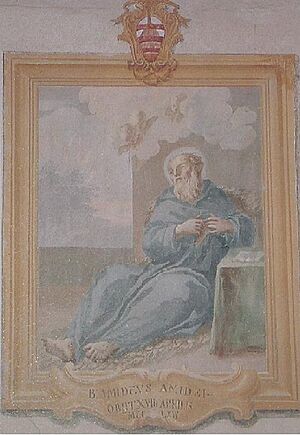Seven Holy Founders of the Servite Order facts for kids
Quick facts for kids Seven Holy Founders of the Servite Order |
|
|---|---|
| Venerated in | Roman Catholic Church |
| Beatified | 1 December 1717 by Clement XI |
| Canonized | 15 January 1888 by Pope Leo XIII |
| Feast | 17 February |
The Seven Holy Founders of the Servite Order were seven friends from Florence, Italy. Their names were Bonfilius, Alexis, Manettus, Amadeus, Hugh, Sostene, and Buonagiunta. They were very devoted to Mary, mother of Jesus. One day, they all had a special vision at the same time, though they didn't know it until they talked. This vision called them to "leave the world" and serve God better.
These men were: Bonfilius Monaldi, Alexis Falconieri (born around 1200, died February 17, 1310), Benedict dell'Antella (Manettus), Bartholemew Amidei (Amadeus, died 1265), Ricovero Uguccioni (Hugh), Gerardino Sostegni (Sostene), and John Manetti (Buonagiunta).
Contents
Meet the Founders
Alexis Falconieri: A Life of Humility
Alexis Falconieri was one of the seven special men who started the Servite Order. We celebrate all seven of them on the day Alexis passed away.
Early Life and Calling
Alexis was the son of Bernardo Falconieri, a rich merchant and leader in Florence. His family was part of the Guelph party. This group often disagreed with the Ghibellines, who supported the emperor. Even though Alexis came from a wealthy family, he lived a very humble life.
Alexis joined a religious group called the Laudesi, who honored Mary. There, he met the six friends who would join him in his spiritual journey. On August 15, 1233, Alexis and his six friends all had a vision of Mary. Soon after, they decided to start the Order of the Servites.
Starting the Servite Order
Alexis gave up his worldly life and moved to a house outside Florence. The next year, he moved to Monte Senario, where they built a hermitage and a church. Alexis was known as a "Founder and Mystic." At first, they didn't accept new members. But in 1240, with help from the bishop of Florence, they began to welcome novices.
The new order followed the rules of Augustine of Hippo and the Dominicans. They wore black robes and lived in towns, acting like friars. The Servite Order was officially recognized in 1259 and approved by Pope Benedict XI in 1304. It is still one of the twelve Mendicant orders in the Catholic Church.
Alexis's Service and Legacy
Alexis was very humble and often begged for money to help his fellow brothers. This was a common way for holy people like Francis of Assisi and Saint Dominic to fight corruption in the church. Alexis never became a priest.
His main work was to provide for the religious communities where he lived. In 1252, a new church was finished under his guidance, with financial help from his relative. Because of Alexis, his niece Juliana Falconieri also chose to live a religious life at a young age.
Soon, thousands of people joined the Servite Order. New communities were started in places like Siena, Pistoia, and Lucca. Over the years, the order spread worldwide, reaching England and the USA in the 1800s. The Servites helped develop three important ways to honor Our Lady of Sorrows: the Rosary of the Seven Sorrows, the Black Scapular of the Seven Dolours of Mary, and the Novena to Our Sorrowful Mother.
Alexis died in Monte Senario on February 17, 1310, at about 110 years old. His body is buried near the church of the Santissima Annunziata in Florence. On December 1, 1717, Pope Clement XI declared Alexis worthy of honor. He gave the same honor to his six companions on July 3, 1725.
Amadeus of the Amidei
Amadeus of the Amidei (died 1265) was one of the seven founders of the Servite Order in 1233. He was also known as Bartolomeo degli Amidei. He was born into the Amidei family in Florence. He passed away at Monte Senario in 1265. His feast day is celebrated on February 17, along with the other six founders.
Hugh dei Lippi Ugguccioni
Hugh dei Lippi Ugguccioni was another founder. He followed Philip Benizi to France and Germany. Hugh stayed there to serve as a leader for the order. He died in Germany on May 3, 1282.
Their Lasting Impact
Pope Leo XIII officially declared all seven founders saints on January 15, 1888. Their feast day was first celebrated on February 11. This date marked the day the order received official approval in 1304. In 1909, February 11 became the feast day of Our Lady of Lourdes. So, the founders' feast day was moved to February 12. For a calendar update in 1969, February 17 was chosen as the most fitting date. This is the day Alexis Falconieri died.



